Within the state of California, there are several climates and temperature zones, making it the 3rd biggest state in the United States with a total area of 155,973 square miles. One of the few places in the United States where old-growth temperate rainforests may be found is in Northern California’s Redwood National Forest. The state is home to a wide range of birds, including both common and rare owls. Keep reading to learn about the 14 different owl species found in California, as well as some identification images and useful hunting advice.
SPECIES OF OWLS IN CALIFORNIA
Barn Owl, Flammulated Owl, Western Screech-owl, Great Horned Owl, Snowy Owl, Northern Pygmy-owl, Elf Owl, Burrowing Owl, Spotted Owl, Barred Owl and Long-eared owl are the 14 species of owls found in California.
1. NORTHERN SAW-WHET OWL
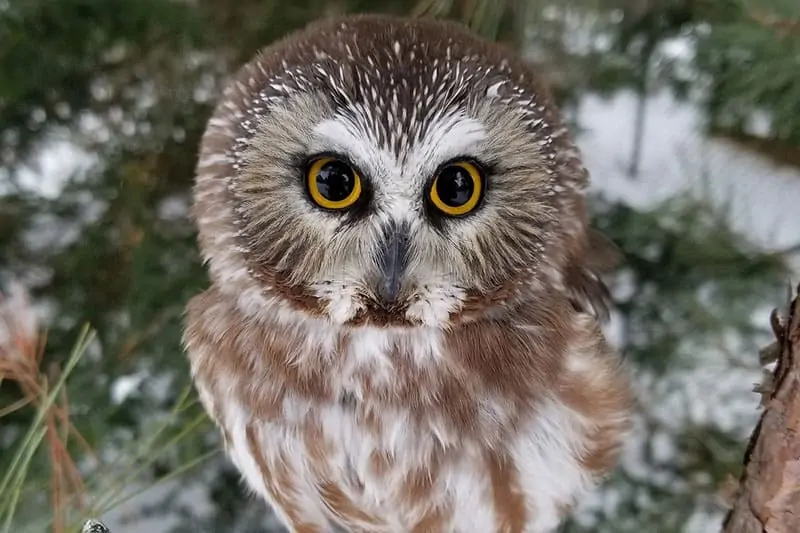
Length: 7.1-8.3 in
Weight: 2.3-5.3 oz
Wingspan: 16.5-18.9 in
Northern Saw-whet Owls can be found year-round in the majority of Northern California. These have a non-breeding range just in parts of Central and Southern California. Because of their small size, cryptic coloring, and retiring habits, these owls prefer to live in thick coniferous woods and groves.
It’s so good at remaining unnoticed in places where it happens that it’s frequently spotted perched motionless. To make locating it easier, listen for its high-pitched “too-too-too” call. Males will make this call for hours during the breeding season, making it easy to hear and see.
Consider putting up a nesting box for Northern Saw-whet Owls if you live in California and are in an area where they breed. In addition to housing a breeding pair of owls, it will increase your chances of getting up-close with these small birds by providing a habitat for them.
2. BARN OWL
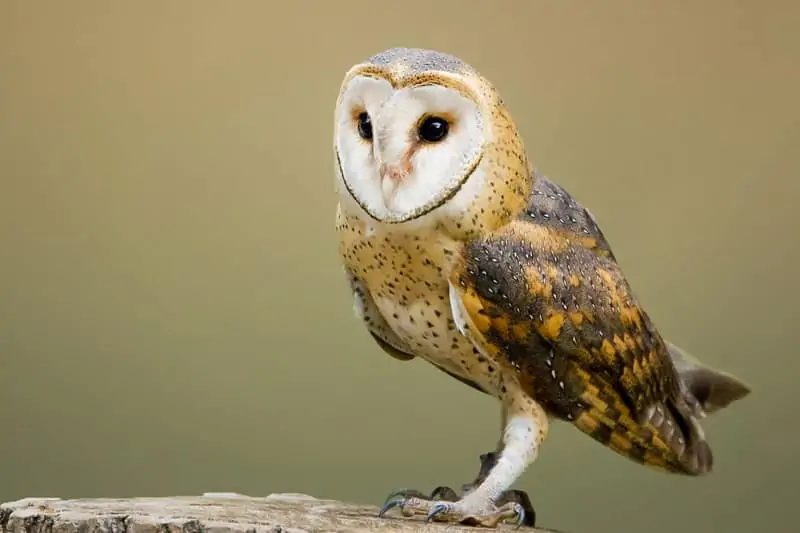
Length: 12.6-15.8 in
Weight: 14.1-24.7 oz
Wingspan: 39.4-49.2 in
In America and across the globe, Barn Owls are common. They may be found in woodlands and open areas throughout the year in California. They are known as the “barn” owl because they like to roost and nest in tranquil, abandoned structures. The majority of these owls’ diets are made up of rodents like mice and voles, which are commonly found on farmland. Using their razor-sharp vision and hearing, they quietly fly close to the ground at night, locating prey in the darkest of settings.
The faces of these owls are pale, with dark watchful eyes. They’re about the size of a crow, and they’re medium-sized owls. Their cries aren’t cheerful, cheery hoots, but rather harsh, raspy growls. Listen for a burst of white glide by as they call in the evening once the sun has set.
3. NORTHERN PYGMY-OWL
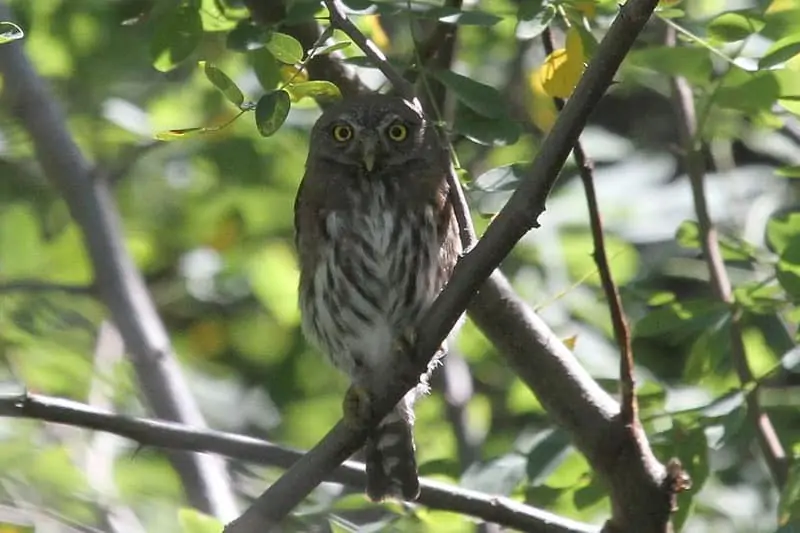
Length: 6.4-7.1 in
Weight: 2.1-2.5 oz
Wingspan: 14.5–16 in
The mountainous western United States, and particularly northern and coastal California, are home to the Northern Pygmy-Owls. They can be found year-round in sparse places of the state. Because they are active during the day, seeing them is easier than seeing most other nocturnal owls. They’re also tiny, so you’ll need to keep your eyes open because they’ll sit still waiting for prey.
To make locating them easier, try to learn about their high-pitched toots and calls. Groups of singing birds may be paying attention to you, too. They’ll frequently mob a Northern Pygmy-Owl if they find it, pleading with it to depart. Since small birds account for a significant portion of a Northern Pygmy-Owl’s diet, it’s only fair. A birder who imitates a Northern Pygmy-Owl’s call might be mobbed by these songbirds and chickadees.
4. WESTERN-SCREECH OWL

Length: 7.5-9.8 in
Weight: 3.5-10.8 oz
Wingspan: 21.6-24.4 in
Throughout most of California, Western-screech Owls may be found year-round. They have stocky bodies and short tails, and they’re tiny robin-sized owls. When they’re roosting in holes during the day, their mostly gray-brown plumage with streaked undersides perfectly hides them among trees. They hunt at night, perched quietly and still until they catch their prey and fly away. In addition to reptiles, fish, and small birds, they’ll capture insects in mid-flight to supplement their diet.
Waiting for other nocturnal owls to call is frequently the best way of finding Western-screech Owls, since it’s similar to trying to find them. High-pitched toots that speed up slightly at the end make up their calls. If you live in their range, install a nesting box in your yard for these owls.
5. GREAT HORNED OWL

Length: 18.1-24.8 in
Weight: 32.1-88.2 oz
Wingspan: 39.8-57.1 in
The Great Horned Owl is frequently what comes to mind when someone thinks about owls. These owls have huge, cat-like eyes, long tufts on their heads, thick stocky bodies, and a deep, unknown hoot that are all characteristics associated with story-book owls.
They may be found year-round in California, and they are one of the most common owls across North America. The Great Horned Owls can be found in a wide range of environments, but woodlands with plenty of open areas are where they prefer to hunt. These huge owls can take down prey that is much bigger than themselves, and they are aggressive hunters.
Rodents, reptiles, and birds as big as hawks and geese are among the animals they eat. Because of the soft feathers that cover their whole bodies, they are able to fly quietly and dive bomb their victim.
6. SHORT-EARED OWL

Length: 13.4-16.9 in
Weight: 7.3-16.8 oz
Wingspan: 33.5-40.5 in
In Northern California, year-round, and in the winter in Central and Southern California, you’ll often find Short-eared Owls. Due to their frequent daytime activity and preference for open areas like fields and grasslands, they are one of the easier owl species to identify. With a look that seems to be weightless, they have large, rounded wings that allow them to fly close to the ground.
Short-eared Owls, unlike other owls, are frequently seen sitting directly on the ground. Their heads seem to be absolutely smooth, despite the fact that their name suggests they have short ears. They do have tufts, but they’re small and difficult to spot.
7. GREAT GRAY OWL
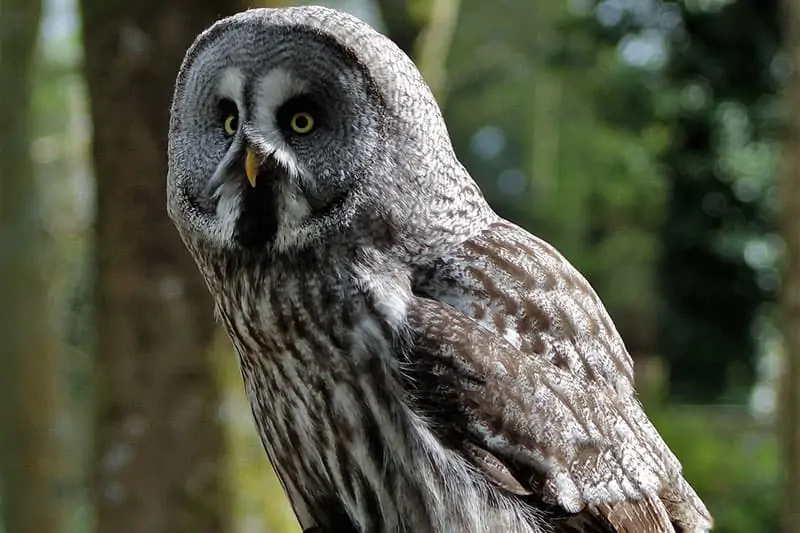
Length: 24.0-33.1 in
Weight: 24.7-60.0 oz
Wingspan: 53.9-60.2 in
Year-round, in Northeastern California, Great Gray Owls may be found. They are some of the tallest owls in America, with huge wings and a long tail. Their large facial disks give them a distinct look because their eyes appear tiny and close together. Another identifier is a white “X” pattern on their faces. Their bodies are covered in soft, silvery gray feathers, as their name implies.
These owls aren’t the most introspective of birds; they’re rather reserved and solemn. They avoid human-populated areas and dwell in thick pine woods and around the margins of meadows. They are most active at night, hunting most often in the hours leading up to dusk and dawn, like other owls.
8. LONG-EARED OWL

Length: 13.8-15.8 in
Weight: 7.8-15.3 oz
Wingspan: 35.4-39.4 in
Long-eared Owls may be found in Central California year-round, with the exception of their non-breeding habitat. These owls are generally widespread, although they are quite elusive. They are difficult to spot because of their secrecy. They wake up at night to hunt after roosting throughout the day in thick foliage.
They blend dark browns and grays to blend in with their surroundings, which helps them stay hidden. The long tufts on the crowns of their heads give them the appearance of having ears, and this is what gives them their name.
9. BARRED OWL

Length: 16.9-19.7 in
Weight: 16.6-37.0 oz
Wingspan: 39.0-43.3 in
There are isolated places in Northern California where year-round Barred Owl populations may be found, albeit they are uncommon. These owls are most often seen in swamps in the south-eastern United States. Woodlands and forests near bodies of water are the best places to look for them in Washington State.
They’re most active at night, but they may also call and hunt during the day. Seeking for these owls in the trees usually yields better results than listening for their unique, rich-sounding “who cooks for you?” call.
Barred owls have stocky bodies and smooth, rounded heads. Their eyes are huge and seem to be completely black because of their deep brown color. Their plumage is speckled with white and brown mottling, with vertical brown bands on the lower sides and upper parts.
10. SPOTTED OWL

Length: 18.5-18.9 in
Weight: 17.6-24.7 oz
Wingspan: 39.8 in
California Spotted Owls are only found in a few scattered places around the state throughout the year. The Spotted Owl’s habitat has been severely diminished, resulting in a significant population decline. Survival is more difficult for these owls due to competition with Barred Owls. In the state’s far north, you may also encounter Northern Spotted Owls.
With broad, rounded wings, short tails, and spherical heads, Spotted Owls are slightly smaller than Barred Owls. They have white dappling over most of their body and are mostly dark brown. A white “X” symbol on their face disks aids in their identification. Spotted Owls, like most owls, hunt for small animals, chiefly rats, at night. On still evenings near woodlands, their loud, deep hoots may occasionally reverberate for up to a mile.
11. SNOWY OWL

Length: 20.5-27.9 in
Weight: 56.4-104.1 oz
Wingspan: 49.6-57.1 in
During irruptive migrations, snowy owls may be seen in the state, but this isn’t common. Snowy Owls are mostly seen in the arctic tundra and much of Canada throughout the winter during other seasons. They’re most often sighted in vast areas like fields when they first enter the state.
The snowy plumage of the Snowy Owls, which covers their enormous, spherical bodies, sets them apart from other owls. Males have fewer black and dark brown markings on their bodies than females. The eyes of both sexes are a deep yellow color.
12. BURROWING OWL
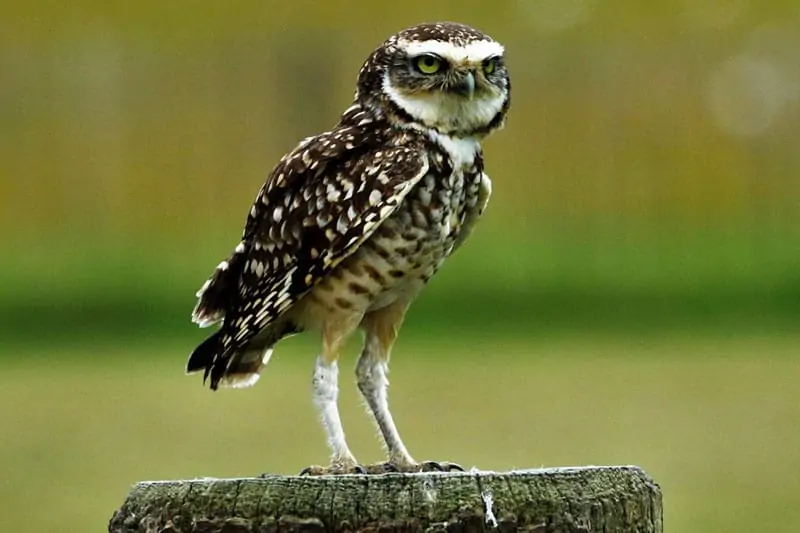
Length: 7.5-9.8 in
Weight: 5.3 oz
Wingspan: 21.6 in
Breeding populations of Burrowing Owls may sometimes be seen in south-eastern parts of California, despite their more common presence further south in America. In Southern California, there is also a population of year-round Burrowing Owls.
Wide areas of grassland and prairie are their primary habitats. Burrowing Owls, unlike most owls, raise their young in tunnels and dens excavated underground. During incubation and brooding phases, these clever owls will store extra food in these subterranean hideaways.
Burrowing Owls have stockier bodies than robins and are about the same height and length. They have sandy-colored plumage with brown markings and smooth, spherical heads with no ear tufts. These owls, like many others, hunt prey without having to fly. Instead, with their long legs, they pursue insects and small animals on the ground.
13. FLAMMULATED OWL
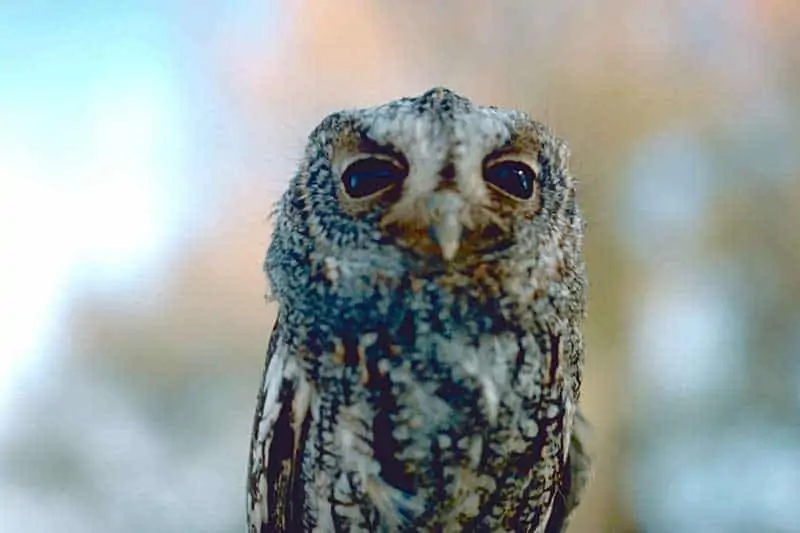
Length: 5.9-6.7 in
Weight: 1.5-2.2 oz
Wingspan: 15.9-16.1 in
While they are fairly frequent where they may be discovered, Flammulated Owls are just seen during the breeding season in a few areas of California. They have a similar shape to screech-owls but with shorter tufts on the crowns of their heads and are quite small in size.
Their pale gray-brown plumage blends in perfectly with tree bark, making spotting them frequently difficult. These owls rest during the day and hunt at night in mature pine woodlands, which they prefer to occupy. It’s much simpler to see them at night than it is to observe them during the day. To locate them, listen for their stealthily low hoot. Their calls, on the other hand, frequently seem farther away than they are, which might make this accomplishment a challenge.
14. ELF OWL
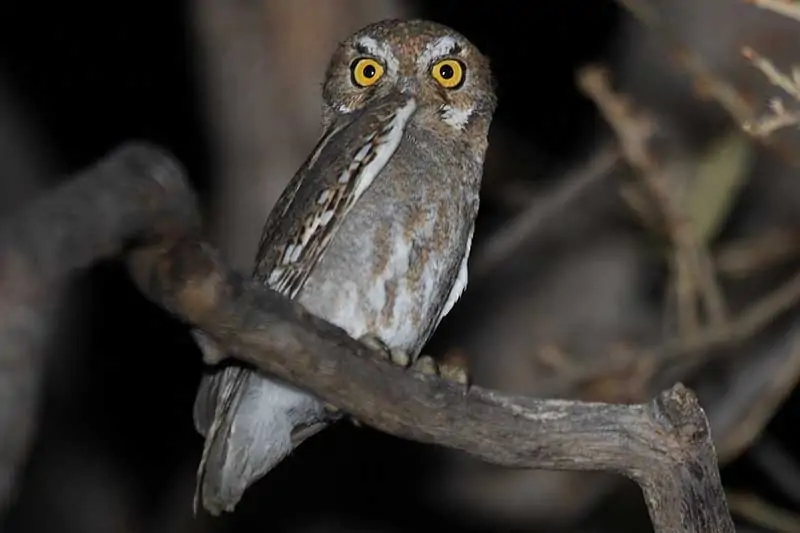
The breeding range of Elf Owls extends from Baja California in the south to San Diego. They’re barely about the size of a sparrow, making them California’s and the world’s smallest owls. Throughout the spring and summer, look for them in California, and during the winter, look for them in Mexico.
The small size, lack of ear-tufts, and brownish-gray feathers distinguish Elf Owls from regular owls. Insects and arthropods are the primary sources of food for them, although they will occasionally consume small lizards and blind snakes. Due to habitat destruction, Elf Owls have been almost wiped off the California endangered species list.
